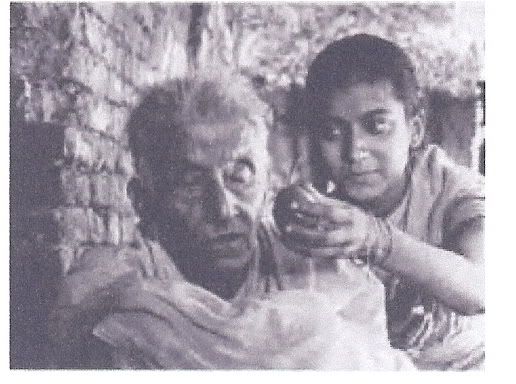
Photo: Durga gives her grandmother the stolen guava.
Those of you who used to visit me at the old AOL Journal may remember I did some entries on fairytales and myths, including Thumbelina and Persephone. Those stories have become very central in my thinking about how to tell women's stories. I finished a story this summer that somewhat draws from archetypes present in Thumbelina and Persephone. I'm working on another that also draws from the same archetypes. I think one of the breakthroughs writers make is when they recognize these ancient patterns in modern life.
As I worked on this latest story, I couldn't help thinking about a favorite movie of mine, Pather Panchali, which is no longer available to buy at Amazon, unfortunately, but which can be rented pretty easily enough.
I've read several reviews of Pather Panchali, and not one really talks about the women in the film to my satisfaction, so I hope to do that here as a way of emphasizing the Maiden/Mother/Crone archetype. Most of the reviews I've seen call Durga (the "maiden") a petty thief. I disagree, and here is my take on the movie. I've canabalized from my Amazon review. I do those from time to time, as a "no pressure way "to sharpen the critical skills.
Reviews generally focus on the main character, Apu, yet Pather Panchali is also a powerful portrayal of various phases of women's lives: maiden, mother, and crone.
Durga, the maiden, is often described as a petty thief, yet her acts often seem heroic to me and serve to underscore the pettiness and selfishness of her neighbors. Durga steals guavas and also a set of beads. Why should Durga have to steal guavas from the land that used to belong to her father? Why can't the neighbors share? They know the family is struggling with everyday survival. Does Durga eat the guavas herself? No, she gives them to her grandmother.
As for stealing the beads, Durga's desire for something pretty, while not so heroic, is perfectly understandable when one takes into account how little Durga is appreciated in a family that dotes on Apu, the boy. Yet there are no villains in this movie. All characters are fully rounded. The mother, who often seems cruel, is also a sympathetic character who tries to keep her pride in tact while descending deeper into poverty all the time.
(In fact, Durga's mother also "steals" a guava. This happens much later in the movie and suggests to me that the mother now understands the maiden's motivation for "stealing" the guavas: love).
The grandmother (Crone) is, to me, the best character in the whole movie. She's as mysterious as she is mischevious. The petty bickering between Durga's mother and grandmother doesn't show an absence of love but results from the pressures of day to day survival. The women, in fact, are woven into the same tapestry of life. In one brilliant shot, the mother is shown holding her weary back while the grandmother, bent from years of hardship and work, shuffles in the background. Life is hard and the inevitability of old age is just around the corner. How is one's hard work and sacrifice repaid? Are we destined to end up like Durga's grandmother, whom nobody seems to want? Nobody, save Durga, who has a pure heart and shows her love by bringing lovingly her hungry grandmother stolen guavas.
Yes, this is the story of Apu, a young boy, but it's also the story of the three main phases of women's lives.
Remembering ancient patterns of storytelling have become invaluable to me. These patterns exist deep within our psyche, and readers will recogize them when they read your stories.



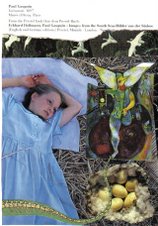


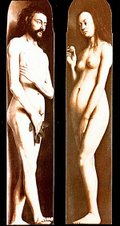

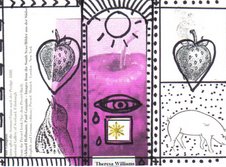
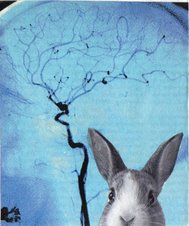
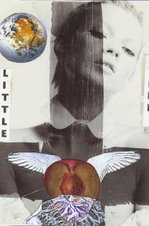
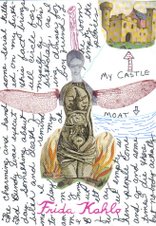


4 comments:
"The legend of the first film is inspiring; how on the first day Ray had never directed a scene, his cameraman had never photographed one, his child actors had not even been tested for their roles--and how that early footage was so impressive it won the meager financing for the rest of the film. Even the music was by a novice, Ravi Shankar, later to be famous."
"It is like a prayer, affirming that this is what the cinema can be..."
Roger Ebert
Satyajit Ray is a master director. The women in this film are strong, resilient, just as Ray's mother, who raised him alone. Don't miss a single frame.
Gretchen
Love the pics!
Theresa, I`m with you. The mythos is, to me, [wo]man`s continuing attempt to make sense of his/her existence. All of what is presently done in art, the sciences, will one day in the future be our contribution to the Mythos.
V
I'm going to find this and watch it. Once again, I wish I were close enough to take one of your classes. I know I would enjoy it so much.
Judi
I have reserved this video from the library and will be watching it. Thanks for the review.
Post a Comment